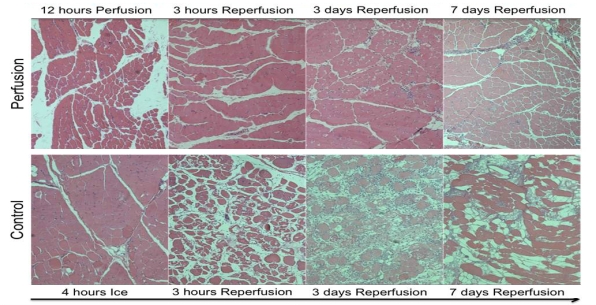Ex Vivo Perfusion of Porcine Forelimbs to Prolong Allowable Ischemia Time.
1Department of Surgery, Division of Plastic Surgery, Brigham and Women's Hospital, Harvard Medical School, Boston
2Department of Plastic Surgery, Burn Center, Sarcoma Reference Center, BG University Hospital Bergmannsheil, Bochum, Germany
3Department of Hand, Plastic and Reconstructive Surgery, Burn Trauma Center, BG Trauma Center Ludwigshafen, Heidelberg, Germany.
Meeting: 2016 American Transplant Congress
Abstract number: C105
Keywords: Gene expression, Ischemia, Preservation
Session Information
Session Name: Poster Session C: Ischemia Reperfusion Injury and Organ Preservation
Session Type: Poster Session
Date: Monday, June 13, 2016
Session Time: 6:00pm-7:00pm
 Presentation Time: 6:00pm-7:00pm
Presentation Time: 6:00pm-7:00pm
Location: Halls C&D
Purpose
Successful replantation in patients suffering from traumatic amputation of one or more extremities is limited by the muscle ischemia time of 4-6h, which also holds true for VCA transplantation. We investigated the use of ex vivo perfusion to extend the ischemia time beyond this threshold.
Methods
In a large animal model, porcine forelimbs were amputated and either perfused with an extracorporeal membrane oxygenation device and adapted acellular perfusion solution (Perfadex®) for 12h at 10[deg]C (treatment; n=3) or stored on ice slurry at 4[deg]C (control; n=4) before replantation. Animals were sacrificed on day 7. Histologic and electron microscopy assessment, gene expression profiles and cytokine assays, as well as clinical parameters, blood gas and urine analysis were compared between groups.
Results
Histopathological evaluation showed less tissue damage during perfusion (6.47% hypoxic cells in control after 4 hours vs. 0.77% in treatment, p=0.005)and after replantation in the treatment group(33.66% damaged cells in control vs. 11.55% in treatment, p=0.05 ). Animals in the treatment group had fewer difficulties in recovering early after surgery in terms of transient accelerated heart rates, cardiac dysrhythmias and decrease of oxygen saturation in the first 3 hours post-op. Gene expression profiling showed activation of the hypoxic pathway (HIF1-α&β) in the control group with maximum 24 hours after reperfusion.

Conclusion
Ex vivo perfusion of amputated limbs can extend the allowable ischemia time up to 12h. This has important clinical implications because one of the current major limitations for limb allotransplantation is the short muscle ischemia time resulting in a limited time window and accompanied limited donor pool for transplantation.
CITATION INFORMATION: Krezdorn N, Kueckelhaus M, Dermietzel A, Alhefzi M, Aycart M, Fischer S, Win T.-S, Kiwanuka H, Bueno E, Pomahac B. Ex Vivo Perfusion of Porcine Forelimbs to Prolong Allowable Ischemia Time. Am J Transplant. 2016;16 (suppl 3).
To cite this abstract in AMA style:
Krezdorn N, Kueckelhaus M, Dermietzel A, Alhefzi M, Aycart M, Fischer S, Win T-S, Kiwanuka H, Bueno E, Pomahac B. Ex Vivo Perfusion of Porcine Forelimbs to Prolong Allowable Ischemia Time. [abstract]. Am J Transplant. 2016; 16 (suppl 3). https://atcmeetingabstracts.com/abstract/ex-vivo-perfusion-of-porcine-forelimbs-to-prolong-allowable-ischemia-time/. Accessed January 4, 2026.« Back to 2016 American Transplant Congress
